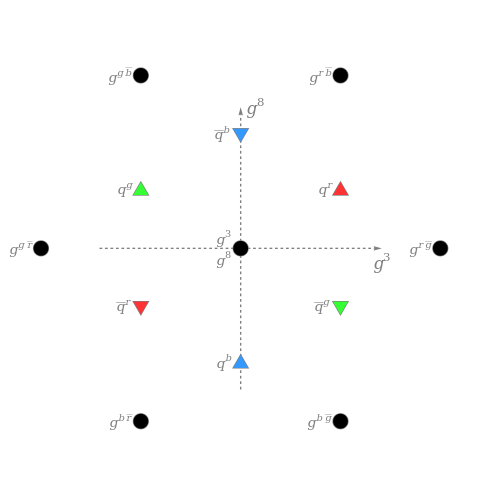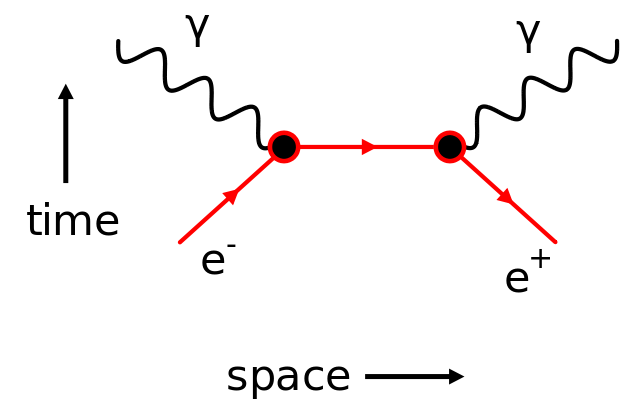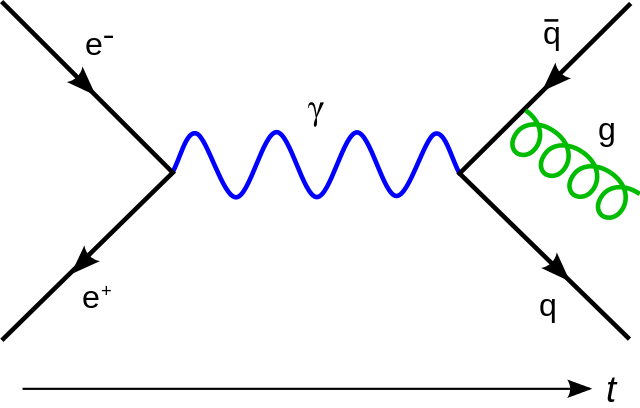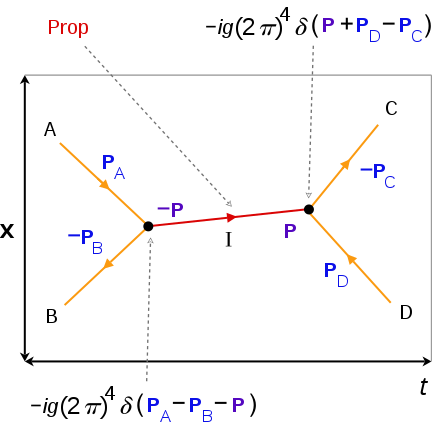Newton was worried by his theory of gravity.
He thought it unscientific because the force of gravity was having to act
through empty space, so there was nothing to transmit the force. This worry was
ignored for centuries, but it is just as valid for the electric forces that
travel through a vacuum as for gravity. Even on the small scale of the nucleus, there seemed to be ‘nothing’ in between the nucleons that could carry the
strong nuclear force. Modern physics recognises Newton’s problem and solves it
by saying that the forces between particles are carried by other particles.
These are the exchange particles or bosons. The table below lists the bosons needed to explain the four fundamental interactions.
FORCES AND INTERACTIONS
Forces always exist as pairs: when two particles exert any kind of force on each other, the force on one is the same as the force on the other, each acting in the opposite direction. This effect is called interaction between the particles. We commonly refer to the four fundamental interactions: electromagnetic, weak, strong and gravitational. As we shall see, when particles interact, there is always another particle that ‘carries the force’ – it ‘mediates the interaction’. The mediating force-carrying particles known as exchange particles are in a group called gauge bosons – see the table below. It is the possibility of virtual particles that underlies the idea of gauge bosons as particles that ‘mediate the interaction’ between particles.
Modern theory suggests that at very high energies all these forces merge into just one. There is experimental evidence that at very high energies the electromagnetic and weak forces are unified – they become the electroweak force.
Gauge bosons
| Interaction | Particle | Relative strength |
| Strong | gluon (g) | 1 |
| Electromagnetic | Photon (γ) | 10-2 |
| Weak | W, Z bosons | 10-7 |
| Gravity | Graviton (not yet found) | 10-36 |

TIME SCALES OF INTERACTIONS
Each interaction has a characteristic time scale (which is quoted as a half-life. The stronger the force, the quicker things happen, so when two hadrons interact due to the strong force, events happen on a time scale shorter than about 10-10 s. This also applies to a hadron’s internal change (an ‘interaction’ involving one particle), which we observe as a spontaneous decay.
In the weak interaction, things happen slowly. Normal weak interactions produce decays in about a millionth of a second – very slow by particle interaction standards. For example, a pi meson might decay in about 10-8 s by converting its two quarks into a muon and a neutrino via the weak interaction (mediated by a W boson).
The time scale of an interaction or change can be measured in detectors. The time gives valuable clues about the event involved, and hence the type of particle produced, even though it is not ‘seen’ by the detector.
PHOTONS
The most familiar boson is the photon, which carries the electromagnetic force (interaction) between charged particles. In a diagram of an electron repelling another electron via the exchange of a virtual photon. This diagram is realistic: it is a Feynman diagram, summarising a continuous and complicated process. In the gauge boson model of charged particles interacting, each particle is surrounded by a cloud of virtual photons. When one particle nears another, they exchange virtual photons. Since photons carry momentum there is an associated momentum exchange that we observe as a force causing a change in the velocity of both particles. The force mediated by photons can pull as well as push. At this level the concept of force is not very useful in fact, it is better to work purely in terms of momentum changes.

Feynman diagram of electron/positron annihilation. bitwise - My creation, Public Domain.
Imagine two electrons approaching each other. They exert a repulsive force on each other and do this by exchanging carriers of the electromagnetic force – photons. The closer they get to each other the more particles are exchanged, like eighteenth-century warships exchanging cannon balls. The photons are of course virtual particles which are never actually observed, something perfectly acceptable according to the uncertainty principle. Despite this, they carry momentum between the electrons which are both turned from their paths, conserving momentum in an elastic ‘collision’.
W AND Z PARTICLES
The weak interaction can be mediated by one of two sorts of W particle, or a Z particle. W particles carry either positive or negative charge but Z particles carry no charge. A W particle changes either a quark or a lepton. The carriers of the weak force have been detected outside a nucleus. Unlike photons, they have mass, of about 90 GeV/c2.
GLUONS
When quarks interact inside a proton the force carrier is the gluon. The force is a short-range force of attraction – the strong nuclear force. Imagine the quarks moving around inside the small space – which has no ‘boundary wall’ – like angry ferrets in a sack kept together by mutual aggression! The gluon exchanges ‘colour force’ just as the photon exchanges electromagnetic force. The interaction changes the colours of the quarks as illustrated in the Feynman diagram below. Gluons do not carry electric charge and are massless. They can change the colour of a quark but not its flavour (i.e. upness, downness, strangeness, etc.). The forces holding nucleons inside a nucleus are the result of gluons leaking temporarily, for quantum reasons, between one quark system (a proton, say) and another. Bear in mind that gluons always pull, whilst photons can both pull and push.
Spin
An important property of photons, bosons, nuclei and nuclear particles is a characteristic called spin, an abbreviation for spin angular momentum. We imagine the particle rotating about its axis, as the Earth spins about the line joining its poles. But in quantum physics spin is quantised, and must have values such as 0, ½, 1, 3/2 etc, in units of ћ. The spin of a photon is linked with polarisation in the wave model. A photon has unit spin. The spinning of electrons and atomic nuclei gives rise to their magnetism. Electrons have spin ½. For hadrons (baryons like protons, and mesons), the spin is the sum of the spins of the particles of which they are made: quarks. All quarks have half-integer spin: ½. This means that ordinary baryons with three quarks have spin 3/2, while mesons with two quarks have spin 1.
INTERACTIONS, DECAYS AND FEYNMAN DIAGRAMS
Feynman diagrams model what is believed to happen when particles interact with each other and/or decay. They are named after Richard Feynman, who devised the diagrams to help illustrate such exchange processes. The diagram is not a picture of what happens; it just reminds us of the particles involved, and is used to keep track of particles and changes in complex interactions. It needs a very complex wave-quantum calculation to describe an interaction between particles completely.

READING A FEYNMAN DIAGRAM
The vertex: The vertex is where things happen. In the figure, a down quark changes into an up quark and emits an exchange particle. This has to carry away negative charge and is a W- boson. Time goes from left to right. Particles are shown as straight lines with time arrows which meet at the vertex, and the particle symbol is at the free end of the line. The electromagnetic and weak bosons (photons, W and Z) are shown by a wavy line. There is no need for an arrow as they slope to show them moving forward in time.
Next, the exchange particle creates a vertex. The virtual (W-) particle materialises into a pair of leptons: a particle (e-) and an antiparticle (an electron neutrino). But the neutrino has an arrow pointing back against the direction of time! This is because of the lepton conservation rule. A single lepton can’t come from anywhere. The change at the vertex has to maintain a lepton number of zero. What comes out must go in. The convention, therefore, is that an antiparticle is always shown entering a vertex against the direction of time. It is thought of as a particle going forward in time. It really does work!
Combining vertices into Feynman diagrams
The full beta decay of a neutron is shown in the diagram of beta decay of a neutron. A neutron becomes a proton when one of its d quarks becomes a u quark. The exchange particle W- becomes a lepton pair. The neutron has turned into a proton. In the figure showing the two vertices for positive muon decay. Positive muons are antiparticles of the ordinary negative muon. A positron and two neutrinos are emitted, with W+ as the exchange particle.
In high-energy collisions between particles, an electron can collide with a proton and ‘reverse beta decay’ to form a neutron. An up quark in the proton changes to a down quark accepting the negative charge brought by the electron, mediated by the W- boson. The antineutrino is there to balance the lepton books.
Gluons as exchange particles
In a collision between high-speed protons in high-speed protons producing a positive pion. There is enough energy to tear a gluon from a quark, which in turn carries enough energy to produce two more quarks. These have the same flavour but must be a quark-antiquark pair. But it is the u quark and the antidown quark that combine to make the pion. Other outcomes are possible involving the weak interaction, and the higher the energy of the colliding protons the more particles are produced, as discussed in this chapter.
Virtual particles are unseen
Many new particles are produced by the collision of high-energy electrons and positrons in ring accelerators. Their production always involves the production of one or more virtual particles whose temporary and unseen existence can be inferred from the results, using Feynman diagrams which tend to be pretty complex!

To summarise
Feynman diagrams are combinations of vertices at which things happen. They are to be read from left to right – the direction of time. Particles are shown by straight lines. Exchange particles (bosons) link vertices, and are shown by wiggly lines, without arrows. W particles are lepton-changing or quark-changing particles. Arrows show movement in time. Antiparticles are represented by arrows going backwards in time.
THE DECAY OF QUARKS
Mesons are short-lived: they contain a particle and an antiparticle. When a pion decays it forms a muon and a muon neutrino. Neither muons nor neutrinos contain quarks – they are leptons. ‘Quarkness’ is conserved, since a pion contains a quark and an antiquark. The decay is mediated by a W+ particle. This is shown in the Feynman diagram. As explained above, neutron decay (ordinary radioactive beta decay) is also the consequence of a quark decay. This is through the weak interaction, so needs the mediation of a W particle, in this case, a W-. A down quark has changed to an up quark. Again ‘quarkness’ is conserved, and so is baryon number.
Quarks and the weak interaction
When a reaction is mediated by the weak interaction, one type of quark is always changed into another. The weak interaction is the only interaction that can do this. In all other cases, new quarks may be formed, but are formed in quark-antiquark pairs so that the total quantity of ‘quarkness’ remains constant. This is another way of saying that baryon number is conserved: a quark has baryon number +1/3 and its antiquark baryon number is -1/3.
For example, in the following strong reaction:
p- + p → n + π+ + π- + π0
The quarks on the left side are (ȗȗđ) and (uud). On the right we have (udd), (uđ), (ȗd) and (uȗ). The extra quarks on the right side are a (uȗ) pair and a (dđ) pair. In other words, if we count a quark as +1 and an antiquark as -1, the total quarkness on the left (3) equals the sum on the right. The best known weak reaction is neutron decay.
n → p + e- + ṽe
On the left the quarks are (udd). On the right only the proton contains quarks (uud). Quarkness (baryon number) is conserved, but a down quark has turned into an up quark. This seems a minor result, but consider the reaction:
K+ → π0 + π+
On the left, the K+ has quarks (uŝ). On the right, the π0 can be either a (uȗ) or a (dđ) and the π+ is (uđ). Quarkwise, the π0 is self-cancelling. But to make the π+ a strange antiquark has become a down antiquark. This is the reason why strangeness is conserved in strong reactions, but may not be conserved in weak reactions. Whenever a quark changes type in a reaction, we can point to the weak interaction as its cause.
Till next time, I remain my humble self, @emperorhassy.
REFERENCES
http://hyperphysics.phy-astr.gsu.edu/hbase/Particles/expar.html
https://en.wikipedia.org/wiki/Exchange_force
https://www.britannica.com/science/fundamental-interaction
https://thewonderofscience.com/3-forces-and-interactions
https://www.nextgenscience.org/topic-arrangement/3forces-and-interactions
https://www.bbc.co.uk/bitesize/guides/zthdgdm/revision/1
https://en.wikipedia.org/wiki/W_and_Z_bosons
http://hyperphysics.phy-astr.gsu.edu/hbase/Particles/expar.html
https://www.sciencedaily.com/releases/2008/02/080217143832.htm
https://home.cern/news/news/physics/four-decades-gluons
https://www.britannica.com/science/gluon
https://en.wikipedia.org/wiki/Gluon
https://web.mit.edu/dikaiser/www/FdsAmSci.pdf
https://physics.stackexchange.com/questions/168964/having-trouble-understanding-feynman-diagrams
https://www.quantumdiaries.org/2010/02/14/lets-draw-feynman-diagams/
https://en.wikipedia.org/wiki/Feynman_diagram
https://www.quora.com/How-do-you-understand-read-Feynmans-diagram
https://www.open.edu/openlearn/science-maths-technology/particle-physics/content-section-7
@tipu curate
Downvoting a post can decrease pending rewards and make it less visible. Common reasons:
Submit
Thanks, @magicmonk.
Downvoting a post can decrease pending rewards and make it less visible. Common reasons:
Submit
no problem! very well written!
Downvoting a post can decrease pending rewards and make it less visible. Common reasons:
Submit
Upvoted 👌 (Mana: 10/15 - need recharge?)
Downvoting a post can decrease pending rewards and make it less visible. Common reasons:
Submit
This post has been voted on by the SteemSTEM curation team and voting trail. It is elligible for support from @curie and @minnowbooster.
If you appreciate the work we are doing, then consider supporting our witness @stem.witness. Additional witness support to the curie witness would be appreciated as well.
For additional information please join us on the SteemSTEM discord and to get to know the rest of the community!
Thanks for having used the steemstem.io app and included @steemstem in the list of beneficiaries of this post. This granted you a stronger support from SteemSTEM.
Downvoting a post can decrease pending rewards and make it less visible. Common reasons:
Submit